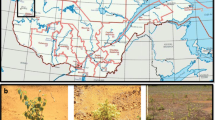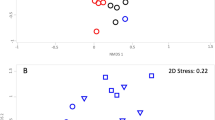Abstract
Mine spoils and other soils contaminated with cadmium, copper, lead and zinc show natural colonization by species which have strategies of avoidance or tolerance of metal toxicities. The distribution of plants on such substrata in the British Isles is examined in the light of present knowledge of such strategies. Evolutionary processes mediating the selection of tolerant individuals and ecotypic differentiation of adapted populations on metalliferous soils are considered. Other factors determining which species can and which cannot evolve tolerance include constitutional differences in species sensitivity to toxic metals, and phenotypic (environmentally-induced) tolerances. The importance of constitutional properties and phenotypic responses in providing explanations for plant distribution on metalliferous soils is assessed.
Similar content being viewed by others
References
Al-Hiyaly, S. A., 1989: Evolution of zinc tolerance under electricity pylons. — Ph.D. Thesis, University of Liverpool.
—, 1989: The effects of zinc contamination from electricity pylons—evolution in a replicated situation. — New Phytol.110: 571–580.
Alvarez, H., Ludwig, J. A., Harper, K. T., 1974: Factors influencing plant colonization of mine dumps at Park City, Utah. — Amer. Midl. Naturalist92: 1–11.
Antonovics, J., 1972: Population dynamics of the grassAnthoxanthum odoratum on a zinc mine. — J. Ecol.60: 351–365.
—, 1975: Metal tolerance in plants: perfecting an evolutionary paradigm. — In Proc. 1st. Int. Conf. Heavy Metals in the Environment, Toronto.2: 169–186. — Canada: University of Toronto.
—, 1971: Heavy metal tolerance in plants. — Adv. Ecol. Res.7: 1–85.
Baker, A. J. M., 1978a: The uptake of zinc and calcium from solution culture by zinctolerant and non-tolerantSilene maritima With. in relation to calcium supply. — New Phytol.81: 321–330.
—, 1978b: Ecophysiological aspects of zinc tolerance inSilene maritima With. — New Phytol.80: 635–642.
—, 1987: Metal tolerance. — New Phytol. (Suppl.)106: 93–111.
—, 1980: Morphological variation between some isolated populations ofSilene maritima With. in the British Isles with particular reference to inland populations on metalliferous soils. — New Phytol.84: 123–138.
—, 1990: Ecophysiology of metal uptake by tolerant plants. — InShaw, A. J., (Ed.): Heavy metal tolerance in plants: evolutionary aspects, pp. 155–177. — Boca Raton, Florida: CRC Press.
—, 1986: Induction and loss of cadmium tolerance inHolcus lanatus L. and other grasses. — New Phytol.102: 575–587.
Bradley, R., Burt, A. J., Read, D. J., 1982: The biology of mycorrhiza in theEricaceae. VIII. The role of mycorrhizal infection in heavy metal resistance. — New Phytol.91: 197–209.
Bradshaw, A. D., 1952: Populations ofAgrostis tenuis resistant to lead and zinc poisoning. — Nature169: 1098.
—, 1984: Adaptation of plants to soils containing toxic metals—a test for conceit. — InEvered, D., Collins, G. M., (Eds.): Origins and development of adaptation. — Ciba Foundation Symposium102: 4–19. — London: Pitman.
Brooks, R. R., Malaisse, F., 1985: The heavy metal-tolerant flora of Southcentral Africa. — Rotterdam: Balkema.
Brown, H., Martin, M. H., 1981: Pretreatment effects of cadmium on the root growth ofHolcus lanatus L. — New Phytol.89: 621–629.
Carter, S. C., Proctor, J., Slingsby, D. R., 1987: Soil and vegetation of the Keen of Hamar serpentine Shetland. — J. Ecol.75: 21–42.
Craig, G. C., 1972: The population genetics ofAgrostis canina with respect to lead tolerance. — M.Sc. Thesis, University of Stirling.
Clark, R. K., Clark, S. C., 1981: Floristic diversity in relation to soil characteristics in a lead mining complex in the Pennines, England. — New Phytol.87: 799–815.
Coughtrey, P. J., 1978: Cadmium in terrestrial ecosystems — a case study at Avonmouth, Bristol. — Ph.D. Thesis, University of Bristol.
—, 1977: Cadmium tolerance ofHolcus lanatus from a site contaminated by aerial fallout. — New Phytol.79: 273–280.
—, —,Shales, S. W., 1978: Preliminary observations on cadmium tolerance inHolcus lanatus L. from soils artificially contaminated with heavy metals. — Chemosphere2: 193–198.
Ernst, W., 1974: Schwermetallvegetation der Erde. — Stuttgart: Fischer.
—, 1976: Violetea Calaminariae. — InTüxen, R., (Ed.): Prodrome of the European plant communities3. — Lehre, W. Germany: J. Cramer.
Ernst, W. H. O., 1983: Ökologische Anpassungsstrategien an Bodenfaktoren. — Ber. Deutsch. Bot. Ges.96: 49–71.
Farrow, S., 1983: Population dynamics ofAgrostis canina on a small copper mine. — Ph.D. Thesis, University of Liverpool.
Fiedler, P. L., 1985: Heavy metal accumulation and the nature of edaphic endemism in the genusCalochortus (Liliaceae). — Amer. J. Bot.72: 1712–1718.
Garcia-Gonzalez, A., Clark, S. C., 1989: The distribution ofMinuartia verna andThlaspi alpestre in the British Isles in relation to 13 soil metals. — Vegetatio84: 87–98.
Garland, C. J., Wilkins, D. A., 1981: Effect of calcium on the uptake and toxicity of lead inHordeum vulgare L. andFestuca ovina L. — New Phytol.87: 581–593.
Gartside, D. W., McNeilly, T., 1974: The potential for evolution of heavy metal tolerance in plants. 2. Copper tolerance in normal populations of different plant species. — Heredity32: 335–348.
Gregory, R. P. G., Bradshaw, A. D., 1965: Heavy metal tolerance in populations ofAgrostis tenuis Sibth. and other grasses. — New Phytol.64: 131–143.
Hajar, A. R. M., 1987: Comparative ecological studies onMinuartia verna (L.)Hiern. andThlaspi alpestre L. in the Southern Pennines, with particular reference to heavy metal tolerance. — Ph.D. Thesis, University of Sheffield.
Halliday, G., 1960: Studies on theArenaria ciliata andMinuartia verna complexes. — Ph.D. Thesis, University of Cambridge.
Heaney, A., Proctor, J., 1983: Vegetation and soil factors on the Jerah Mine, Scotland. — Trans. Bot. Soc. Edinburgh44: 107–114.
Hewitt, E. J., 1966: Sand and water culture methods used in the study of plant nutrition, 2nd edn. — Commonwealth Agricultural Bureau Technical Communication22.
Hogan, G. D., Courtin, G. M., Rauser, W. E., 1977a: The effects of soil factors on the distribution ofAgrostis gigantea on a mine waste site. — Canad. J. Bot.55: 1038–1042.
—, —, —, 1977b: Copper tolerance in clones ofAgrostis gigantea from a mine waste site. — Canad. J. Bot.55: 1043–1050.
Ingram, C., 1988: The evolutionary basis of ecolgical amplitude of plant species. — Ph.D. Thesis, University of Liverpool.
Iingrouille, M. J., Smirnoff, N., 1986:Thlaspi caerulescens J. & C. Presl. (T. alpestre L.) in Britain. — New Phytol.102: 219–233.
Jeffrey, D. W., 1971: The experimental alteration of aKobresia-rich sward in Upper Teesdale. — InDuffey, E., Watt, A. S., (Eds.): The scientific management of animal and plant communities for conservation. — BES Symposium11: 79–89. — Oxford: Blackwell.
Lambinon, J., Auquier, P., 1964: La flore et la végétation des terrains calaminaires de la Wallonie septentrionale et de la Rhénanie aixoise. Types chorologiques et groupes écologiques. — Natura Mosana16: 113–131.
Levitt, J., 1980: Responses of plants to environmental stresses 2, 2nd edn. — New York: Academic Press.
McNaughton, S. J., Folsom, T. C., Lee, T., Park, F., Price, C., Roeder, D., Schmitz, J., Stockwell, C., 1974: Heavy metal tolerance inTypha latifolia without the evolution of tolerant races. — Ecology55: 1163–1165.
Morrey, D. R., Baker, A. J. M., Cooke, J. A., 1988: Floristic variation in plant communities which occur naturally on metalliferous mining residues in the northern and southern Pennines, England. — Environ. Geochem. Health10: 11–20.
Nieboer, E., Richardson, D. H. S., 1980: The replacement of the nondescript term “heavy metals” by a biologically and chemically significant classification of metal ions. — Environ. Poll, Ser.B 1: 3–26.
Page, C. N., 1988: Ferns: their habitats in the British and Irish landscape. New Naturalist Series. — London: Collins.
Reeves, R. D., Baker, A. J. M., 1984: Studies on metal uptake by plants from serpentine and non-serpentine populations ofThlaspi goesingense Halácsy (Cruciferae). — New Phytol.98: 191–204.
Repp, G., 1973: Cytoecological investigations with regard to the mechanism of chemical resistance of plants. — InHutnik, R. J., Davis, G., (Eds.): Ecology of devastated land1, pp. 445–466. — New York, London: Gordon & Breach.
Richards, A. J., Porter, A. F., 1982: On the identity of a NorthumberlandEpipactis. — Watsonia14: 121–128.
—, 1976:Epipactis leptochila (Godfery)Godfery andE. phyllanthes G. E. Sm. occurring in South Northumberland on lead and zinc soils. — Watsonia11: 1–5.
Richardson, J. B., 1974: Metal mining. — InRolt, L. T. C., (Ed.): Industrial archaeology series12. — London: Allen Lance, Penguin Books.
Shaw, S. C., Rorison, I. H., Baker, A. J. M., 1984a: Physiological mechanisms of heavy metal tolerance. — Ann. Rep. Unit of Comparative Plant Ecology (NERC), University of Sheffield, p. 25.
—, —, —, 1984b: Solubility of heavy metals in lead mine spoil extracts. — Environ. Poll., Ser.B, 8: 23–33.
Simon, E., 1978: Heavy metals in soils, vegetation development and heavy metal tolerance in plant populations from metalliferous areas. — New Phytol.81: 175–188.
Smith, R. F., 1979: The occurrence and need for conservation of metallophytes on mine wastes in Europe. — Miner. Environ.1: 131–147.
Smith, R. A. H., Bradshaw, A. D., 1979: The use of metal tolerant plant populations for the reclamation of metalliferous wastes. — J. Appl. Ecol16: 595–612.
Taylor, G. J., Crowder, A. A., 1984: Copper and nickel tolerance inTypha latifolia clones from contaminated and uncontaminated environments. — Canad. J. Bot.62: 1304–1308.
Thompson, J., 1987: Population biology ofAnthoxanthum odoratum, Plantago lanceolata andRumex acetosa on zinc/lead mine spoil. — Ph.D. Thesis, University of Liverpool.
—, 1983: Vegetation and soil factors on a heavy metal mine spoil heap. — New Phytol.94: 297–308.
Waughman, G. J., Kookorinis, E., Bellamy, D. J., 1983: Influences of climate and heavy metal concentrations in the soil on plants of grassland and flush vegetation in Upper Teesdale. — J. Ecol.71: 177–187.
Webb, J. S., 1978: The Wolfson geochemical atlas of England and Wales. — London: Oxford University Press.
Wilkins, D. A., 1978: The measurement of tolerance to edaphic factors by means of root growth. — New Phytol.80: 623–633.
Wu, L., Antonovics, J., 1976: Experimental ecological genetics inPlantago. 2. Lead tolerance inPlantago lanceolata andCynodon dactylon from a roadside. — Ecology57: 205–208.
Author information
Authors and Affiliations
Rights and permissions
About this article
Cite this article
Baker, A.J.M., Proctor, J. The influence of cadmium, copper, lead, and zinc on the distribution and evolution of metallophytes in the British Isles. Pl Syst Evol 173, 91–108 (1990). https://doi.org/10.1007/BF00937765
Received:
Accepted:
Issue Date:
DOI: https://doi.org/10.1007/BF00937765




